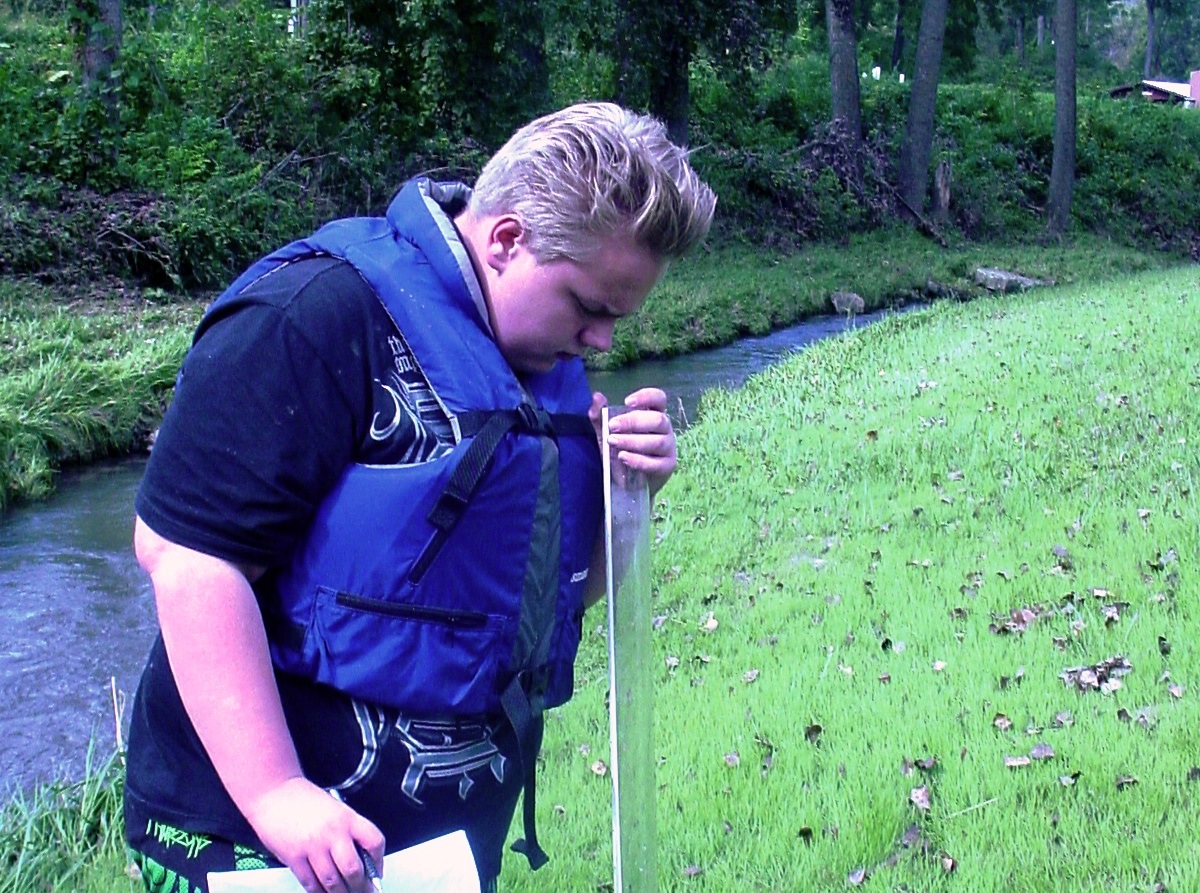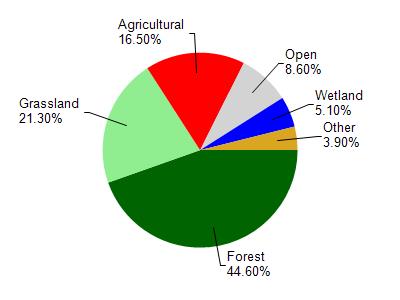
4.54 Miles
0 - 4.54
Cool-Cold Mainstem, Cool-Cold Headwater, Coldwater
Good
Vernon
Yes
No
No
Fish and Aquatic Life
Overview
Hohlfield Creek, also known as Creek 20-16, is located in northwestern Vernon County. In past years this stream was also known as Huff Creek and Swain Hollow Creek. It flows in a southwesterly direction for approximately four miles before reaching Coon Creek west of Chaseburg. Hohlfield Creek has a slight gradient of 18 feet per mile and drains steep forested hillsides and agricultural valley land. Hohlfield Creek is a Class I trout stream for its entire length.
From: Koperski, Cindy. 2002. The State of the Bad Axe - La Crosse Basin. Wisconsin Department of Natural Resources, Madison, WI
Date 2002
Author Cynthia Koperski
Condition
Wisconsin has over 84,000 miles of streams, 15,000 lakes and milllions of acres of wetlands. Assessing the condition of this vast amount of water is challenging. The state's water monitoring program uses a media-based, cross-program approach to analyze water condition. An updated monitoring strategy (2015-2020) is now available. Compliance with Clean Water Act fishable, swimmable standards are located in the Executive Summary of Water Condition in 2018. See also the 'monitoring and projects' tab.
Reports
Management Goals
Wisconsin's Water Quality Standards provide qualitative and quantitative goals for waters that are protective of Fishable, Swimmable conditions [Learn more]. Waters that do not meet water quality standards are considered impaired and restoration actions are planned and carried out until the water is once again fishable and swimmable
Management goals can include creation or implementation of a Total Maximum Daily Load analysis, a Nine Key Element Plan, or other restoration work, education and outreach and more. If specific recommendations exist for this water, they will be displayed below online.
Monitoring
Monitoring the condition of a river, stream, or lake includes gathering physical, chemical, biological, and habitat data. Comprehensive studies often gather all these parameters in great detail, while lighter assessment events will involve sampling physical, chemical and biological data such as macroinvertebrates. Aquatic macroinvertebrates and fish communities integrate watershed or catchment condition, providing great insight into overall ecosystem health. Chemical and habitat parameters tell researchers more about human induced problems including contaminated runoff, point source dischargers, or habitat issues that foster or limit the potential of aquatic communities to thrive in a given area. Wisconsin's Water Monitoring Strategy was recenty updated.
Grants and Management Projects
Monitoring Projects
| WBIC | Official Waterbody Name | Station ID | Station Name | Earliest Fieldwork Date | Latest Fieldwork Date | View Station | View Data |
|---|
| 1645100 | Hohlfeld Coulee Creek | 10013260 | Hohlfeld Coulee Creek (20-16) St. 1 - Bridge On K | | | Map | Data |
| 1645100 | Hohlfeld Coulee Creek | 10009135 | Creek 20-16 #3- Bridge On Schultz Rd. | | | Map | Data |
| 1645100 | Hohlfeld Coulee Creek | 10009133 | Creek 20-16 #2- 69 Feet Upstream Of Cty. K | | | Map | Data |
|
Monitoring Studies
Hohlfeld Creek is a Class I trout stream for its entire length.The most recent surveys, conducted in 2005 and 2007, documented both brook and brown trout populations in Hohlfield Creek. Access to the stream is possible from five road crossings.
Date 2011
Author Aquatic Biologist

Watershed Characteristics
Hohlfeld Coulee Creek is located in the Coon Creek watershed which is 238.20 mi². Land use in the watershed is primarily forest (44.60%), grassland (21.30%) and a mix of agricultural (16.50%) and other uses (17.60%). This watershed has 574.90 stream miles, 4,342.05 lake acres and 6,052.31 wetland acres.
Nonpoint Source Characteristics
This watershed is ranked High for runoff impacts on streams, Not Ranked for runoff impacts on lakes and Medium for runoff impacts on groundwater and therefore has an overall rank of Medium. This value can be used in ranking the watershed or individual waterbodies for grant funding under state and county programs.This water is ranked Medium Stream for individual Rivers based on runoff problems and the likelihood of success from project implementation.
Hohlfield Coulee Creek (20-16) is considered a Cool-Cold Mainstem, Cool-Cold Headwater, Coldwater under the state's Natural Community Determinations.
Natural communities (stream and lake natural communities) represent model results and DNR staff valiation processes that confirm or update predicted conditions based on flow and temperature modeling from historic and current landscape features and related variables. Predicated flow and temperatures for waters are associated predicated fish assemblages (communities). Biologists evaluate the model results against current survey data to determine if the modeled results are corect and whether biological indicators show water quaity degradation. This analysis is a core component of the state's resource management framework. Wisconsin's Riverine Natural Communities.
Cool (Cold-Transition) Mainstem streams are moderate-to-large but still wadeable perennial streams with cold to cool summer temperatures. Coldwater fishes are common to uncommon, transitional fishes are abundant to common, and warm water fishes are uncommon to absent. Headwater species are common to absent,
mainstem species are abundant to common, and river species are common to absent.
Cool (Cold-Transition) Headwaters are small, usually perennial streams with cold to cool summer temperatures. Coldwater fishes are common to uncommon (<10 per 100 m), transitional fishes are abundant to common, and warm water fishes are uncommon to absent. Headwater species are abundant to common, mainstem species are common to absent, and river species are absent.
A 1999 survey documented a streambed consisting mainly of sand and silt, with lesser amounts of gravel and rubble. The riparian land use was pasture and meadow. Fish cover consisted of overhanging vegetation and woody debris with aquatic vegetation and few undercut banks. A naturally reproducing brown trout population, a variety of aquatic invertebrates and minnows were noted. Hohlfield Creek was stocked with brown trout up until 1998. Since 1998, only brook trout have been introduced. Hohlfield Creek should be re-surveyed in a few years to determine the success of stocking wild brook trout. Access to the stream is possible from five road crossings.
Hohlf eld Creek is a Class I trout stream for its entire length.The most recent surveys, conducted in 2005 and 2007, documented both brook and brown trout populations in Hohlfield Creek. Access to the stream is possible from fi ve road crossings.
Date 2011
Author Cynthia Koperski
More Interactive Maps
Maps of Watershed